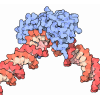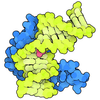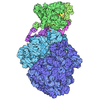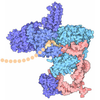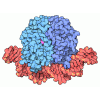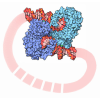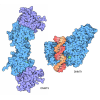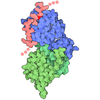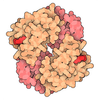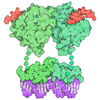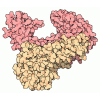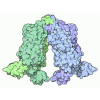+ データを開く
データを開く
- 基本情報
基本情報
| 登録情報 | データベース: PDB / ID: 6wq2 | |||||||||||||||||||||||||||
|---|---|---|---|---|---|---|---|---|---|---|---|---|---|---|---|---|---|---|---|---|---|---|---|---|---|---|---|---|
| タイトル | Cryo-EM of the S. islandicus filamentous virus, SIFV | |||||||||||||||||||||||||||
 要素 要素 |
| |||||||||||||||||||||||||||
 キーワード キーワード | VIRUS / helical symmetry / archaeal virus / rod-like virus / structural protein | |||||||||||||||||||||||||||
| 機能・相同性 | helical viral capsid / DNA binding / DNA / DNA (> 10) / DNA (> 100) / Major capsid protein 1 / Major capsid protein 2 機能・相同性情報 機能・相同性情報 | |||||||||||||||||||||||||||
| 生物種 |   Sulfolobus islandicus filamentous virus (ウイルス) Sulfolobus islandicus filamentous virus (ウイルス) | |||||||||||||||||||||||||||
| 手法 | 電子顕微鏡法 / らせん対称体再構成法 / クライオ電子顕微鏡法 / 解像度: 4 Å | |||||||||||||||||||||||||||
 データ登録者 データ登録者 | Wang, F. / Baquero, D.P. / Su, Z. / Zheng, W. / Prangishvili, D. / Krupovic, M. / Egelman, E.H. | |||||||||||||||||||||||||||
| 資金援助 |  米国, 1件 米国, 1件
| |||||||||||||||||||||||||||
 引用 引用 |  ジャーナル: Proc Natl Acad Sci U S A / 年: 2020 ジャーナル: Proc Natl Acad Sci U S A / 年: 2020タイトル: Structures of filamentous viruses infecting hyperthermophilic archaea explain DNA stabilization in extreme environments. 著者: Fengbin Wang / Diana P Baquero / Leticia C Beltran / Zhangli Su / Tomasz Osinski / Weili Zheng / David Prangishvili / Mart Krupovic / Edward H Egelman /   要旨: Living organisms expend metabolic energy to repair and maintain their genomes, while viruses protect their genetic material by completely passive means. We have used cryo-electron microscopy (cryo-EM) ...Living organisms expend metabolic energy to repair and maintain their genomes, while viruses protect their genetic material by completely passive means. We have used cryo-electron microscopy (cryo-EM) to solve the atomic structures of two filamentous double-stranded DNA viruses that infect archaeal hosts living in nearly boiling acid: rod-shaped virus 1 (SSRV1), at 2.8-Å resolution, and filamentous virus (SIFV), at 4.0-Å resolution. The SIFV nucleocapsid is formed by a heterodimer of two homologous proteins and is membrane enveloped, while SSRV1 has a nucleocapsid formed by a homodimer and is not enveloped. In both, the capsid proteins wrap around the DNA and maintain it in an A-form. We suggest that the A-form is due to both a nonspecific desolvation of the DNA by the protein, and a specific coordination of the DNA phosphate groups by positively charged residues. We extend these observations by comparisons with four other archaeal filamentous viruses whose structures we have previously determined, and show that all 10 capsid proteins (from four heterodimers and two homodimers) have obvious structural homology while sequence similarity can be nonexistent. This arises from most capsid residues not being under any strong selective pressure. The inability to detect homology at the sequence level arises from the sampling of viruses in this part of the biosphere being extremely sparse. Comparative structural and genomic analyses suggest that nonenveloped archaeal viruses have evolved from enveloped viruses by shedding the membrane, indicating that this trait may be relatively easily lost during virus evolution. | |||||||||||||||||||||||||||
| 履歴 |
|
- 構造の表示
構造の表示
| ムービー |
 ムービービューア ムービービューア |
|---|---|
| 構造ビューア | 分子:  Molmil Molmil Jmol/JSmol Jmol/JSmol |
- ダウンロードとリンク
ダウンロードとリンク
- ダウンロード
ダウンロード
| PDBx/mmCIF形式 |  6wq2.cif.gz 6wq2.cif.gz | 1.2 MB | 表示 |  PDBx/mmCIF形式 PDBx/mmCIF形式 |
|---|---|---|---|---|
| PDB形式 |  pdb6wq2.ent.gz pdb6wq2.ent.gz | 989.6 KB | 表示 |  PDB形式 PDB形式 |
| PDBx/mmJSON形式 |  6wq2.json.gz 6wq2.json.gz | ツリー表示 |  PDBx/mmJSON形式 PDBx/mmJSON形式 | |
| その他 |  その他のダウンロード その他のダウンロード |
-検証レポート
| 文書・要旨 |  6wq2_validation.pdf.gz 6wq2_validation.pdf.gz | 1.2 MB | 表示 |  wwPDB検証レポート wwPDB検証レポート |
|---|---|---|---|---|
| 文書・詳細版 |  6wq2_full_validation.pdf.gz 6wq2_full_validation.pdf.gz | 1.4 MB | 表示 | |
| XML形式データ |  6wq2_validation.xml.gz 6wq2_validation.xml.gz | 166 KB | 表示 | |
| CIF形式データ |  6wq2_validation.cif.gz 6wq2_validation.cif.gz | 256.6 KB | 表示 | |
| アーカイブディレクトリ |  https://data.pdbj.org/pub/pdb/validation_reports/wq/6wq2 https://data.pdbj.org/pub/pdb/validation_reports/wq/6wq2 ftp://data.pdbj.org/pub/pdb/validation_reports/wq/6wq2 ftp://data.pdbj.org/pub/pdb/validation_reports/wq/6wq2 | HTTPS FTP |
-関連構造データ
- リンク
リンク
- 集合体
集合体
| 登録構造単位 | 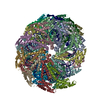
|
|---|---|
| 1 |
|
- 要素
要素
| #1: DNA鎖 | 分子量: 69416.977 Da / 分子数: 1 / 由来タイプ: 天然 由来: (天然)   Sulfolobus islandicus filamentous virus (ウイルス) Sulfolobus islandicus filamentous virus (ウイルス) | ||||
|---|---|---|---|---|---|
| #2: DNA鎖 | 分子量: 68790.570 Da / 分子数: 1 / 由来タイプ: 天然 由来: (天然)   Sulfolobus islandicus filamentous virus (ウイルス) Sulfolobus islandicus filamentous virus (ウイルス) | ||||
| #3: タンパク質 | 分子量: 18901.863 Da / 分子数: 17 / 由来タイプ: 天然 由来: (天然)   Sulfolobus islandicus filamentous virus (ウイルス) Sulfolobus islandicus filamentous virus (ウイルス)参照: UniProt: Q914J5 #4: タンパク質 | 分子量: 22557.898 Da / 分子数: 17 / 由来タイプ: 天然 由来: (天然)   Sulfolobus islandicus filamentous virus (ウイルス) Sulfolobus islandicus filamentous virus (ウイルス)参照: UniProt: Q914J4 Has protein modification | N | |
-実験情報
-実験
| 実験 | 手法: 電子顕微鏡法 |
|---|---|
| EM実験 | 試料の集合状態: FILAMENT / 3次元再構成法: らせん対称体再構成法 |
- 試料調製
試料調製
| 構成要素 | 名称: Sulfolobus islandicus filamentous virus / タイプ: VIRUS / Entity ID: all / 由来: NATURAL |
|---|---|
| 由来(天然) | 生物種:   Sulfolobus islandicus filamentous virus (ウイルス) Sulfolobus islandicus filamentous virus (ウイルス) |
| ウイルスについての詳細 | 中空か: NO / エンベロープを持つか: YES / 単離: STRAIN / タイプ: VIRION |
| 天然宿主 | 生物種: Sulfolobus islandicus |
| 緩衝液 | pH: 6 |
| 試料 | 包埋: NO / シャドウイング: NO / 染色: NO / 凍結: YES |
| 試料支持 | 詳細: unspecified |
| 急速凍結 | 凍結剤: ETHANE |
- 電子顕微鏡撮影
電子顕微鏡撮影
| 実験機器 |  モデル: Titan Krios / 画像提供: FEI Company |
|---|---|
| 顕微鏡 | モデル: FEI TITAN KRIOS |
| 電子銃 | 電子線源:  FIELD EMISSION GUN / 加速電圧: 300 kV / 照射モード: FLOOD BEAM FIELD EMISSION GUN / 加速電圧: 300 kV / 照射モード: FLOOD BEAM |
| 電子レンズ | モード: BRIGHT FIELD |
| 撮影 | 電子線照射量: 44 e/Å2 フィルム・検出器のモデル: FEI FALCON III (4k x 4k) |
- 解析
解析
| ソフトウェア | 名称: PHENIX / バージョン: 1.16_3549: / 分類: 精密化 | ||||||||||||||||||||||||
|---|---|---|---|---|---|---|---|---|---|---|---|---|---|---|---|---|---|---|---|---|---|---|---|---|---|
| EMソフトウェア | 名称: PHENIX / カテゴリ: モデル精密化 | ||||||||||||||||||||||||
| CTF補正 | タイプ: PHASE FLIPPING AND AMPLITUDE CORRECTION | ||||||||||||||||||||||||
| らせん対称 | 回転角度/サブユニット: 38.49 ° / 軸方向距離/サブユニット: 5.48 Å / らせん対称軸の対称性: C1 | ||||||||||||||||||||||||
| 3次元再構成 | 解像度: 4 Å / 解像度の算出法: OTHER / 粒子像の数: 167500 / 対称性のタイプ: HELICAL | ||||||||||||||||||||||||
| 拘束条件 |
|
 ムービー
ムービー コントローラー
コントローラー





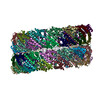


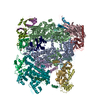

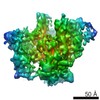
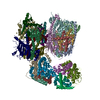
 PDBj
PDBj